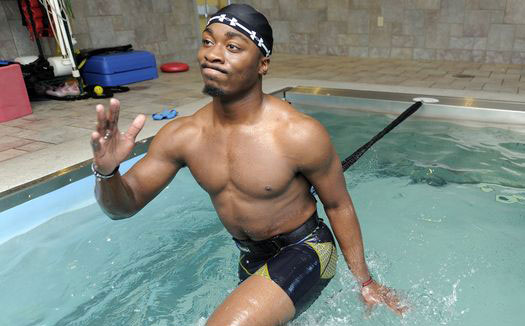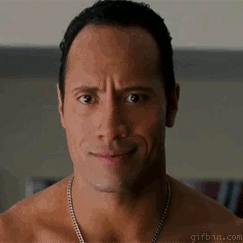I was going to write a post for the Seahawks draft in a similar style to the other NFC West draft writeups, but I didn’t get far in before I started to realize that it read like a re-run. So instead, I’m just going to throw up a few quick additional thoughts that I didn’t express in my immediate post draft reaction.
Spencer Ware is a player I really want to see make it here long term
I don’t know if Spencer Ware is going to make our roster, but I really hope he does. The more I researched him after the draft the more impressed I became. Ware has speed that I’d compare to Justin Forsett, but more than makes up for it with Marshawn Lynch type agility and outstanding resilience/balance on contact. If Seattle has ever drafted someone worthy of a Marshawn Lynch comp, it’s Spencer Ware. For one game at least, Matt Waldman once opined that Spencer Ware was a better back than his then teammate Stevan Ridley. Stevan Ridley, the guy who just rushed for 1200+ yards in New England last year.
Ware probably won’t make the team as a traditional running back, but can you imagine if he became a quality fullback with that kind of versatility as a pass catcher and runner? It’s a lot of fun to think about. Especially in Seattle’s offense where the fullback is a versatile position and is a major part of the offensive game plan, even in the passing game.
I hope Seattle doesn’t rule out Ware as a runner, either. If given a chance to carry the football, I could see him as being a slower yet more elusive version of Chris Ivory.
Seattle didn’t draft a kicker
For the second straight offseason, the Seahawks let Steven Hauschka twist in the wind during free agency before eventually signing him to a cheap one year deal. The Seahawks waited so long that I began to wonder if the draft might have been “plan A” for the kicker position. In a surprise move, Seattle signed Hauschka back just a few days before the draft, then didn’t even bother adding another kicker from the draft process.
Steven Hauschka has done a terrific job with the Seahawks. Under fifty yards he was perfect last season: 23 for 23. From fifty plus he was 1 for 4. The NFL average for fifty plus is around 50%. If Hauschka makes just one more long kick he’s at the NFL average. You don’t have to be a statistician to know that 4 attempts is a small sample size and shouldn’t be taken all that seriously. Tim Tebow completed 75% of his passes last season in just 8 pass attempts. See what I mean?
Josh Brown regularly nailed 50+ yard attempts while struggling for distance on kickoffs. Hauschka has plenty of leg on his kickoffs so I don’t think there are any physical limitations in play. Remember too that Pete Carroll once trusted Hauschka with a 61 yard attempt to decide a game. He failed miserably, but Pete wouldn’t have made that choice if he didn’t at least think Hauschka had a strong leg.
Some have pointed out that Seattle had a very high number of punts inside the opponent’s 40 yard line last season. That and Hauschka’s very low number of 50 yard attempts does seem to hint at a lack of confidence, doesn’t it? Seattle arguably lost a game last season (at Rams) because of the difference in kicker range, and that game would have been the difference between a wildcard and a bye. Amazing how little things add up, isn’t it?
Those concerns are fully valid, though I think it has more to do with Pete Carroll’s new found conservative approach to decision making. “Big Balls Pete” has been burned more than a few times, and every time it happens he becomes more and more hesitant to take chances. Statisticians frequently point out that going for 4th downs is actually a very smart thing, and I can’t imagine that opting for a punt at the 35 yard line is ever optimal as a long term approach.
Pete Carroll’s position is as secure as it gets in the NFL right now- I think it’s time he put his fears behind him and brought “Big Balls Pete” back. Ironically, it’s that overly conservative trait that has helped Hauschka remain in Seattle. Going 23-23 from under fifty goes a long way for a coach that progressively seems to be more and more risk averse.
The Seahawks are a great team with high expectations, and in my opinion Steven Hauschka deserves to be our kicker. Given his phenomenal short range accuracy, distance on kickoffs, and small sample size on long kicks, I see plenty of evidence that suggest he could be a good kicker from longer range in the future, should the team put more trust in him. Seattle needs to punt less from inside the forty, but I think that’s a lot more on Pete’s shoulders than Hauschka’s.
No quarterback was drafted and no quarterback was added from the post-draft process
Nothing shocked me more than hearing John Schneider casually mention during a post-draft press conference that the team had decided to not draft any quarterback this year, and that decision was made before the draft took place. That’s pretty crazy when you consider Seattle’s current backup situation and the kind of value that fell into day three (and undrafted free agency) for the position. Now we know why Seattle kept passing on Matt Scott and others.
For a guy that came from Green Bay, where they preach drafting a quarterback every year, John Schneider has been anything but. Sure, he’s stocked up on quarterbacks, but nearly all of them came from trade or free agency. The only quarterback to actually be drafted during this regime is Russell Wilson.
So I guess the next question is “why?” The most logical answer is that they really like their current group of young veteran backups.
Brady Quinn has been a terrible NFL quarterback, but he’s also a former 1st round pick and isn’t without talent. Seattle briefly brought in former 1st round pick JP Losman in 2010 who was a similar story. They courted former first round pick Matt Leinart and allegedly had discussions behind closed doors regarding former 1st round pick Tim Tebow. They went hard after Chad Henne last year. Henne just missed being a first rounder. So I think in Seattle’s mind, they are always looking for quarterbacks with talent, even if they were miserable washouts elsewhere. I imagine that Blaine Gabbert’s agent will probably get a call from Seattle in the next few years.
While I hate missing out on Matt Scott, I also appreciate that he is a highly injury prone player who played at just 210 pounds. He’d be a big risk for injury every time Seattle ran a read option play. Jerrod Johnson offers a similar package of mobility and arm talent in a body that’s 40 (!) pounds heavier. Johnson had a terrific junior season before crapping the bed in his final year at Texas A&M. And though he only threw 21 passes last preseason, those 21 passes added up for a preseason YPA of 11.2 and a preseason passer rating of 136.2. His lowest passer rating in any of those appearances was 118.8. This was a small sample size compounded by preseason competition, but it’s not nothing.
And he’s only a year older than Josh Portis. Imagine how we’d react if Josh Portis had been that impressive last preseason.
Johnson gives a surprisingly good interview as well. He may not have a ton of future trade potential, but I don’t see why he couldn’t be at least another T-Jack.
That leaves us with Josh Portis, who kind of got railroaded by a quarterback competition last year that left him almost no reps and threw him into a Raiders game with nowhere near adequate preparation. I think the staff took the lesson of last preseason to heart and decided that four preseason quarterbacks is enough. That might have been a factor in the decision to not draft a quarterback as well.
Other thoughts
I get that Seattle wants to get Jesse Williams on the field this season, but giving him the Alan Branch role is not going to end well and given Pete’s willingness to adapt I suspect it will only be temporary. Jesse Williams is a fantastic run defender but has short arms and showed essentially zero pass rush ability in college. He’s a pure nose tackle, and should be used as such. That said, he has the tools to replace Red Bryant as the run defense 5-tech specialist, and quite honestly I think that’s the politically incorrect reason that they actually drafted him for. Going out and announcing such right now in the open would be bad for relations with Red Bryant and given his leadership role on the defense it could cause locker room divisions.
So I get it. Williams will “officially” be our 3-tech until some future undetermined time that Seattle opts for a new direction with Red Bryant. Seattle has done a good job keeping these intentions (real or not) away from the noses of the press. Even still, I hope Williams only sees action at the 3-tech when it’s very likely to be a running play by the opponent, because those are the only plays you’ll want to see him out there barring a revelation from Dan Quinn.
Chris Harper is the one pick I just can’t get excited about. In a way, he’s a little like Landry Jones the receiver. Both are guys with the kind of size and physical talent to be high picks, but both have games that are so bad you wouldn’t be blamed for taking them completely off your draft board. Chris Harper’s performance against Baylor was almost unwatchable, and it’s not like his struggles were isolated to just that one game. He gives up on plays, stabs at the ball with poor catching technique, frequently looks clueless when the ball is in the air, fumbles often, and struggles to separate. When I scouted him over three games the negatives overwhelmed the positives.
That said, the Seahawks know perfectly well what Harper’s issues are and they drafted him anyway. When most other front offices do this, I’d unflinchingly call it a mistake, but when Seattle does it they always do so with a specific plan in mind for how they will address that player’s weaknesses and problems while getting the most out of his unique strengths. Maybe their plan fails and Harper ends up a miserable bust, but you can’t say that Seattle made this pick on the seat of their pants or without knowing what they were doing.
Harper is pretty unique. He’ll be one of the NFL’s heaviest receivers on day one, and of that list of heavy receivers, not many stand 6’1″ or less. That bulk will help Harper defeat press attempts better than most, and given the direction the league is going, we’ll probably see a majority of teams running press coverage within a few years. Harper wouldn’t have been my choice, but if you just wanted a guy that can beat press, Harper was the best there was in this draft class.
I really hope Tharold Simon can stay focused and motivated here in Seattle. He wasn’t perfect at LSU by any means, but when he looked good he looked very good, and like Richard Sherman he’s got a bit of a “cocky” streak in his personality that makes him fun to watch. John Schneider clarified that he traded up for Simon, not Williams. Clearly, he was a player they felt they needed to get.
Last thought. After the 2012 draft John Schneider talked about how the two players he felt he had to walk out of there with were Bruce Irvin and Russell Wilson. Recently John invoked that anecdote when discussing 5th round tight end Luke Willson, saying that Willson was the one player this year that they felt they needed to leave the draft with. It’s not every day you hear that kind of talk for a guy that was selected 158th overall and was the backup tight end for Rice.
But you don’t find 251 pound tight ends that run a 4.51 forty every day. Those numbers are almost identical to Saints’ tight end Jimmy Graham. And when you do find specimens like that, they usually have almost no experience or skated by on athleticism instead of intelligence. Willson was a 3 year player at the position with some production before 2012, and he gives such a professional interview that you’d be forgiven for thinking he was a coach.
Similar to Chris Harper, Luke Willson may not be an all-world player on film, but for just one unique purpose he’s tough to beat. Tight ends that run a 4.51 are really tough to defend and will likely force defenses to run more nickle packages. Expect Willson to lead the team in yards per catch, because when he does get targeted, it will usually be on a deep route while being covered by a linebacker. If Wilson finished with more than 20 catches next year, I’d be surprised. But those catches could easily add up to 300 yards and could force defenses to make adjustments when he’s on the field. Even if he’s not targeted, should his presence force the defense to use a nickle package or take a safety out of the box, that means Willson is adding value to Seattle’s running game.
That ability to stretch a defense matters even more with Percy Harvin on board. Harvin’s bread and butter in the bubble screen. Considering how much of Seattle’s offense is built around short yardage plays, it’s easy to see why such a high premium was placed on a player that can stretch the field from an area that the previous version of the team could not threaten deep from.










